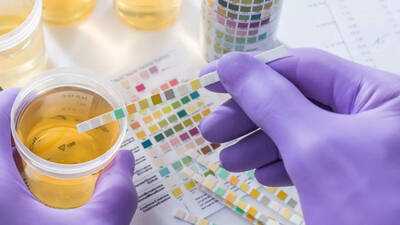Urine is more than just a bodily waste product; it provides an informative window into an individual’s health, reflecting hydration status, dietary habits, and potential medical conditions. While most people pay little attention to the hue of their urine, subtle variations in colour can indicate physiological changes or the presence of underlying disease processes. From pale yellow to deep amber, green or even blue tints, each shade carries a biological significance that may warrant closer attention. Recent research, including a detailed case study on blue-green urine , highlights how clinicians use colour as a diagnostic clue, linking it to infections, metabolic imbalances, medication effects, and rare medical syndromes.
Normal urine colour and hydration status: Why pale yellow is ideal
Typically, urine ranges from pale yellow to light amber, a shade primarily determined by urochrome, a pigment produced during the breakdown of haemoglobin. Pale yellow urine usually reflects adequate hydration, while darker urine suggests concentrated fluids, which may indicate insufficient water intake. Seasonal variations, physical activity, and dietary factors influence hydration status, making urine colour a simple, non-invasive method to monitor fluid balance. Observing urine hue can help individuals optimise water intake and prevent complications associated with chronic dehydration, such as kidney stones or urinary tract disorders.
- Typical urine ranges from pale yellow to light amber.
- Colour is primarily determined by urochrome from haemoglobin breakdown.
- Pale yellow urine usually indicates proper hydration.
- Darker urine can suggest concentrated fluids and potential dehydration.
How diet and medications affect the colour of your urine
Dietary components and pharmaceuticals can dramatically modify urine colour. Foods like beets, blackberries, or asparagus can temporarily produce red, pink, or green hues, usually harmless and transient. Water-soluble vitamins, particularly B-complex supplements, may cause bright yellow or fluorescent urine due to excess being excreted. Medications including rifampicin, phenazopyridine, and certain chemotherapeutic agents are well-documented for inducing unusual tints, ranging from orange to deep red. The Diagnostic Approach to Abnormal Urine Colors study emphasises the importance of recognising medication-induced colour changes to avoid misinterpretation as a pathological event.
- Foods such as beets, blackberries, and asparagus may alter urine colour temporarily.
- B-complex vitamins can result in bright yellow or fluorescent urine.
- Certain medications, including rifampicin and phenazopyridine, can cause orange, red, or other unusual tints.
- Recognising diet- and drug-induced changes prevents unnecessary medical concerns.
What red, brown, or blue-green urine might indicate about your health
Persistent or unusual urine colours often indicate underlying medical conditions. Red or pink urine may result from haematuria, which can signal urinary tract infections, kidney stones, or renal pathology. Brown or cola-coloured urine can suggest liver dysfunction, as seen in bilirubinuria, or severe muscle breakdown releasing myoglobin. Green or blue urine, though rare, may arise from urinary tract infections caused by Pseudomonas species, certain medications, or metabolic disorders such as familial hypercalcemia or porphyria. The blue-green urine case study illustrates how abnormal colours provide crucial diagnostic clues.
- Red or pink urine may indicate haematuria, urinary tract infections, or kidney stones.
- Brown urine can suggest liver dysfunction or severe muscle breakdown.
- Green or blue urine may arise from infections, medications, or rare metabolic disorders.
- Persistent abnormal colours often require further medical investigation.
What foamy or cloudy urine could reveal about your kidneys
The texture and clarity of urine, alongside colour, reveal additional health information. Foamy urine often indicates elevated protein levels, known as proteinuria, which may signal kidney damage or chronic conditions such as diabetes and hypertension affecting renal function. Cloudy urine can be a marker of urinary tract infections, where white blood cells, bacteria, or crystals create turbidity. Observing these physical changes in combination with colour variations can provide early warning signs of systemic health issues.
- Foamy urine can indicate elevated protein levels (proteinuria).
- Proteinuria may result from kidney damage or chronic diseases like diabetes.
- Cloudy urine can signify urinary tract infections or the presence of crystals.
- Texture and clarity, combined with colour, provide diagnostic clues.
Persistent urine colour changes: When should you see a doctor
While transient urine colour changes are generally harmless, persistent or unexplained alterations warrant professional evaluation. Symptoms such as pain, dysuria, fatigue, or systemic illness accompanying abnormal colours strengthen the case for seeking medical advice. Urinalysis, imaging, and metabolic studies may be performed to identify underlying conditions, ranging from infections to liver, kidney, or metabolic disorders. The blue-green urine study demonstrates that even rare colour changes can be significant, highlighting the diagnostic potential of urine observation.
- Persistent or unexplained colour changes should prompt medical assessment.
- Associated symptoms like pain or fatigue increase concern.
- Diagnostic testing may include urinalysis, imaging, and metabolic studies.
- Rare colours can provide valuable information about underlying conditions.
Can urine colour help track wellness and hydration?
Urine colour is increasingly recognised as a practical, non-invasive health monitoring tool. Wearable hydration trackers and colourimetric charts help individuals maintain optimal fluid balance. Scientific research continues to investigate the molecular mechanisms behind pigment production, metabolic byproducts, and microbial interactions affecting urine hue. By combining clinical insight with everyday observation, urine colour can serve as a reliable biomarker for hydration, early detection of disease, and personalised wellness monitoring.
- Urine colour is a non-invasive biomarker for hydration and health.
- Wearable hydration trackers and charts can guide fluid intake.
- Research explores pigment production, metabolites, and microbial influences.
- Observation of urine colour supports personalised health monitoring and early detection of disease.
Disclaimer: This article is for informational purposes only and should not be considered medical advice. Please consult a healthcare professional before making any changes to your diet, medication, or lifestyle.
Also Read |
